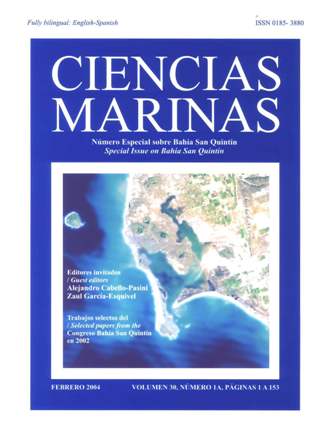Nutrient dynamics in the west arm of San Quintín Bay, Baja California, Mexico, during and after El Niño 1997/1998
Main Article Content
Abstract
Time series of 8 h (May, September and November 1997, and March 1998) and 24 h (June and September 1999, and February 2000) were carried out at two (1997–1998) or three sites (1999–2000) of the west arm (Falsa Bay, FB) of San Quintín Bay, in order to assess the nutrient dynamics during and after the 1997/1998 El Niño event. Chlorophyll a concentrations were also determined during each time series. Non-conservative fluxes of dissolved inorganic phosphorus (∆DIP), dissolved inorganic nitrogen (∆DIN), nitrates (NO3–) and ammonium (∆NH4+) were estimated using a nutrient budget model. High NH4+ peaks (18–45 µM) were detected during El Niño 1997/1998, and the mean concentration values were higher than those of 1999–2000. Ammonium concentration was consistently less than 8 µM during 1999–2000. Significant correlations (r = 0.60 to 0.80) were found between tidal height and NO3– concentration in 1999–2000, as well as an inverse relationship between nitrates and salinity, thus reflecting the input of new DIN from the ocean. Chlorophyll a concentration was up to two times higher in 1999–2000 than during El Niño. There were no significant correlations between tidal height and nutrient concentration during 1997–1998, suggesting that: (a) the high NH4+ concentrations found in 1997–1998 were due to in situ remineralization of the organic matter and, possibly, the excretion by cultured mollusc bivalves in FB, and (b) the increase of chlorophyll a and NO3– during 1999–2000 was mainly due to new inputs from the adjacent ocean. The positive ∆DIP values (0.1 to 0.57) and negative values of the net ecosystem metabolism (NEM = –1 to –60 mmol m–2 d–1) observed throughout 1997–2000 indicate that FB permanently exported DIP towards the ocean and behaved as a net heterotrophic system, with or without the presence of El Niño.
Downloads
Article Details
This is an open access article distributed under a Creative Commons Attribution 4.0 License, which allows you to share and adapt the work, as long as you give appropriate credit to the original author(s) and the source, provide a link to the Creative Commons license, and indicate if changes were made. Figures, tables and other elements in the article are included in the article’s CC BY 4.0 license, unless otherwise indicated. The journal title is protected by copyrights and not subject to this license. Full license deed can be viewed here.

